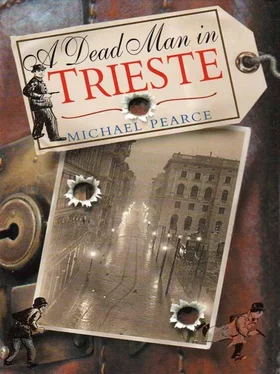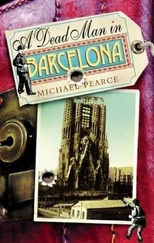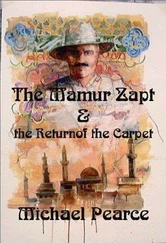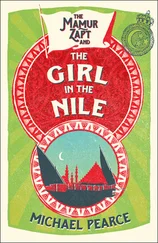Michael Pearce - A Dead Man In Trieste
Здесь есть возможность читать онлайн «Michael Pearce - A Dead Man In Trieste» весь текст электронной книги совершенно бесплатно (целиком полную версию без сокращений). В некоторых случаях можно слушать аудио, скачать через торрент в формате fb2 и присутствует краткое содержание. Год выпуска: 0101, Жанр: Исторический детектив, на английском языке. Описание произведения, (предисловие) а так же отзывы посетителей доступны на портале библиотеки ЛибКат.
- Название:A Dead Man In Trieste
- Автор:
- Жанр:
- Год:0101
- ISBN:нет данных
- Рейтинг книги:5 / 5. Голосов: 1
-
Избранное:Добавить в избранное
- Отзывы:
-
Ваша оценка:
- 100
- 1
- 2
- 3
- 4
- 5
A Dead Man In Trieste: краткое содержание, описание и аннотация
Предлагаем к чтению аннотацию, описание, краткое содержание или предисловие (зависит от того, что написал сам автор книги «A Dead Man In Trieste»). Если вы не нашли необходимую информацию о книге — напишите в комментариях, мы постараемся отыскать её.
A Dead Man In Trieste — читать онлайн бесплатно полную книгу (весь текст) целиком
Ниже представлен текст книги, разбитый по страницам. Система сохранения места последней прочитанной страницы, позволяет с удобством читать онлайн бесплатно книгу «A Dead Man In Trieste», без необходимости каждый раз заново искать на чём Вы остановились. Поставьте закладку, и сможете в любой момент перейти на страницу, на которой закончили чтение.
Интервал:
Закладка:
‘It was a civic reception. A big one, the Governor was there. All the consuls were invited. The Casa Revoltella is a house in the Piazza Giuseppina. It used to belong to the Baron Revoltella. He left it to the city when he died. You should go there. You would find it interesting. You would see how the rich in Trieste used to live. And still live, for that matter.’
The house was open to the public and that afternoon, when the city was quiet, Seymour went there. It was, as Koskash had said, an excellent example of the way of life of the old Trieste merchant, with velvet red plush and gilt everywhere. The Baron Revoltella had been one of those who had spotted the significance to Trieste of the opening of the Suez Canal. The Canal’s third entrance, they called Trieste.
The house was full of reminders of the Suez connection, from broad canvases of the Canal itself to a very strange piece of art on the stairs called Cutting the Isthmus , which had a plaque of de Lesseps on one side of its plinth and a plaque of the Khedive Abbas on the other. The whole thing was lit up from time to time by a red bulb held in the fangs of a wrought-iron serpent.
Money dripped from the large gilt chandeliers and showed itself in the thick pile of the carpet on the velvet- railed staircase up which, presumably, the guests had mounted a fortnight ago.
Seymour asked the attendant about the reception. It appeared to have been a splendid occasion, graced by the Governor himself, and at which almost all the commercial and official worthies of the city had been present.
‘The flower of the city,’ said the attendant sentimentally.
And among the flowers, the dandelion, perhaps, in the bouquet, had been Lomax. All the consuls, the attendant assured him, had been present. He produced some photographs of the occasion: of wondrously uniformed men and gorgeously dressed ladies, sashed and fanned. Seymour wondered if Lomax had worn a uniform, too. Did consuls have uniforms? He suspected they did. Especially if they were British.
He wondered, too, how he had felt. Because he would not, surely, have fitted in. The superior people Seymour had encountered at the Foreign Office, yes, they would have fitted in. But Lomax? From what Seymour felt he had learned about him he would have gone with reluctance, arriving late and leaving early, knowing the people, perhaps, but less at ease in these formal surroundings than in the relaxed atmosphere of the cafe tables. Seymour looked for him in the photographs, asking the attendant to point him out, but they couldn’t find him. He was, as ever, the missing man.
In one of the rooms was a large telescope trained on the bay, through which the Baron could watch his ships coming in. Seymour looked at the ships, too, and then idly adjusted the telescope and found himself peering down on the square outside. There was a statue in the middle of the square and a woman standing nearby. The statue — he could read the inscription through the telescope — was of the Archduke Maximilian, a fine figure, bald, bearded and, of course, this being Trieste, in uniform. The woman appeared to be working on it.
Or, just a minute, was she? She had given it a red nose, large breasts with huge red nipples, and red drawers, into the seat of which she was fitting two large balloons.
What the hell was this? Some kind of student prank?
When he came out of the Casa Revoltella the woman was still there. She had added a cigar, stuck, somehow, into the statue’s mouth, and a fish, draped casually over the Duke’s ear.
Amused, and slightly curious, he wandered over towards her.
She stepped back to admire her handiwork.
‘For God’s sake, Maddalena!’ said a voice that Seymour recognized.
‘Alfredo, is that you? You have come at last. Have you brought it?’
‘Yes, but — ’
‘Please, Alfredo! What is art without the recording?’
She draped herself beside the statue while Alfredo assembled an ancient camera upon a tripod. He disappeared for a moment beneath the cloth. Then his head appeared again.
‘Maddalena, is this wise?’
‘I hope not.’
‘No, no. That you should appear in the photograph, I mean.’
‘You think that the artist should not show herself in her work but be somewhere else, indifferently paring her fingernails?’
‘I was merely thinking that offering too faithful a record might be to be unnecessarily helpful to the police.’
‘Perhaps you are right.’
She removed herself from the statue.
Alfredo suddenly noticed Seymour.
‘Maddalena, this is a friend of mine. A friend of Lomax’s too.’
She came over to him.
‘A friend of Lomax’s?’
‘Well, not exactly a friend — ’
‘He has just arrived from London.’
‘From London? You are a consul, too?’
‘No, no. Just a King’s Messenger.’
She moved away.
‘Alfredo!’
‘Yes?’
‘You disappoint me. First, you didn’t want to take my photograph, and now you are friends with kings!’
‘Messenger,’ said Seymour. ‘Just Messenger.’
‘Are you?’ said Alfredo. ‘You didn’t tell me that.’
‘You should choose your friends more carefully, Alfredo. However, since he is also a friend of Lomax’s, I will forgive you this time.’
‘Thank you, Maddalena. And now may I get on with taking the photograph before the policeman gets here from the next piazza?’
He put his head back beneath the cloth.
‘Alfredo.’
‘Yes, Maddalena?’ wearily.
‘A touch of mascara around his eyes, do you think?’
‘No.’
‘Spoiling the ship, you think?’
‘I think the policeman will get here before I finish taking the photograph.’
‘How do you know he is coming?’
‘Because I can see him across the piazza.’
On the other side of the piazza there was a sudden shout and then a piercing blast on a whistle.
‘Maddalena — ’
‘There is no hurry. He is very fat and will take some time to get here.’
Alfredo emerged hurriedly from beneath the cloth.
‘Did you get it?’
‘Of course.’
He lifted off the camera and grabbed the tripod.
‘You run that way,’ said Maddalena, ‘and I will run the other way.’
So this was Maddalena, thought Seymour. The woman, according to Koskash, who might have accounted for Lomax’s sudden enthusiasm for art and who had, perhaps, introduced him to the artists. Well, from what he had so far learned about him, she fitted pretty well with the picture of Lomax that Seymour was beginning to build up. An oddball woman to go with an oddball man.
He could quite see, however, how a woman like Maddalena might appeal to a man like Lomax. He constructed for himself a mental picture of a staid single man who had spent all his life as a conventional diplomat and who had then, suddenly, run into a woman who was completely outside his range of experience, striking — she was beautiful, Seymour suddenly realized, in an odd, offbeat kind of way, he could quite see how an artist might want her to model for him — unconventional, disturbingly so, challenging Lomax (excitingly?) in all his conventional pores, vital — vital enough, perhaps, to pour new blood into a consul’s shrivelled-up veins and make him fancy he could lead a new life, start again in this sunny Mediterranean place, break free from the mould, kick over the traces -
Run away? Walk out on a job that suddenly seemed stale and sterile to him? Run away with Maddalena and start again?
Only he hadn’t run away. At least, not with Maddalena. She was still here. It was only he who had disappeared.
And maybe the whole picture was false, anyway. Maybe she had not had an impact on him quite like that. Maybe he had indeed, for a moment, entertained the fantasy, put a foot over the traces, but then the ingrained caution of the diplomat had reasserted itself, telling him that though it was lovely it was not for him.
Читать дальшеИнтервал:
Закладка:
Похожие книги на «A Dead Man In Trieste»
Представляем Вашему вниманию похожие книги на «A Dead Man In Trieste» списком для выбора. Мы отобрали схожую по названию и смыслу литературу в надежде предоставить читателям больше вариантов отыскать новые, интересные, ещё непрочитанные произведения.
Обсуждение, отзывы о книге «A Dead Man In Trieste» и просто собственные мнения читателей. Оставьте ваши комментарии, напишите, что Вы думаете о произведении, его смысле или главных героях. Укажите что конкретно понравилось, а что нет, и почему Вы так считаете.












